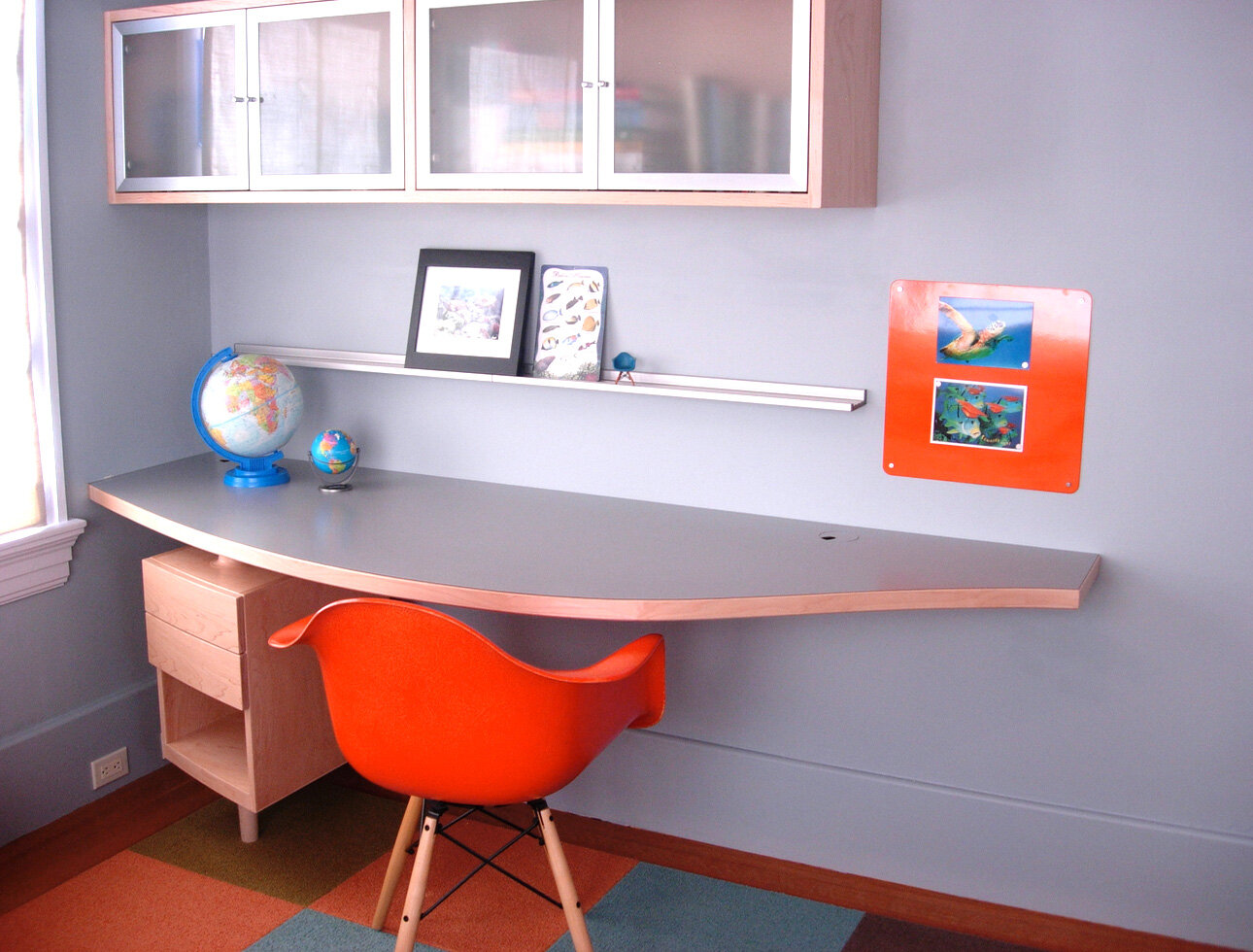Laminates: What's Old is New Again.
Many of our modern materials have been lucky accidents and laminate is no exception. In the early 1900s, Formica became a brand while searching for a new insulation for wiring. Layers of paper were tightly pressed together, i.e., laminated, to form thin, rigid sheets that were then adhered to a wood substrate. By the late 1920s, new printing techniques provided a way to print texture and colors onto the laminates.
These newly decorative surfaces – non-porous, easy to clean, and affordable – eventually found their way to mid-century kitchen and bathroom surfaces, like my kitchen in Boulder, Colorado.
Deep orange laminate countertop in my circa 1970s home in Boulder, Colorado. This is the first whole-house renovation that my husband and I undertook when we purchased it in 2003. (Before image)
Wilsonart stainless steel-like laminate made a child-friendly work desk top for my son in our Berkeley, California home. The edge detail is thin solid maple.
My own Knoll Paperclip Table with a custom laminate top. I’ve been using it as my main family dining table for 21+ years. It still looks like new!
After seeing my kitchen in Boulder, you might be surprised to learn that I chose to use laminate at my next renovation when we relocated to California. The Wilsonart stainless steel-looking desktop in my son’s room in our Berkeley home (pre-Interior Designer days) was a perfect spot for Lego-building and elementary school homework and, unlike an actual metal surface, was a quiet, warm, and easy to clean surface.
If you’ve seen laminate swatches up-close, you can see the thin wood substrate that sheets are adhered to. These are often covered with edge banding. For my son’s desk, the edge was trimmed with thin solid maple to match cabinetry.
Laminates in DBID Projects
As a mid-century modern fan, I have always embraced laminates for their functionality and, especially now, their extensive color and texture palette. In a recent kitchen project, we used Avocado and Orange laminates offered by Kerf Design for the Kerf Wall storage units. The exposed plywood edges and exposed wood layer of the laminate are celebrated rather than concealed with edge banding.
These especially colorful and bright laminates are some of the examples offered by Italian companies Arpa and Abet Laminati.
Laminate surfaces offered by Kerf Wall add color and durability to this Cambridge kitchen.
Custom pet food dish for a Cambridge condo Kerf wall.
Abet Laminati offers laminates in metallics, wood grains, textures and a rainbow of colors.
One of my first professional kitchen projects included a stainless steel appliance garage and adjacent stainless refrigerator/freezer for a Boston kitchen. We used Wilsonart stainless steel-like laminate on the cabinets above the refrigerator/freezer, the end panels, and crown moldings. The laminate was a flexible and cost-effective way to provide the cohesive look of an entire stainless steel wall that this corner needed.
At a mid-century modern home that I am working on now, we are using laminates for mid-century inspired sliding cabinet doors, and for small accessory drawers at the back of the range.
Wilsonart stainless steel-like laminate adds a cohesive look to this Boston kitchen.
Laminates for several kitchen cabinet doors in Abet Laminati laminates in #834 (a red/orange) and #835 (orange). And another popular mid-century product: Heath Tile. These are Dual Glaze tiles in Stone Gray for the same project.
Laminates Last Word
Laminates have been used for countertops, floors, vanity sink surfaces, bar surfaces, and cabinetry. I like using it in my own home and client projects for desk surfaces, shelves and cabinet veneers. Today’s laminates provide great versatility in colors, finishes and patterns, from faux woods to retro patterns reminiscent of the 1950s and 60s. Is there a laminate in your future project? Get in touch and let’s talk about the possibilities.









